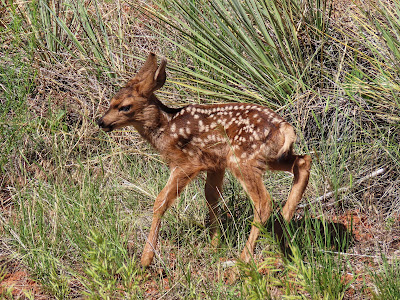What a national treasure is the 1,341-acre park in Colorado Springs. I do not recall coming here when we lived in the area for three years in the early 1970s. Maybe we did and I just don’t remember.
Our visit on this beautiful June 2024 day, I will never forget.
Garden of the Gods is a series of large jutting sandstone formations. They were created by millions of years of geological processes such as uplift, erosion and faulting.
This one is called the Siamese Twins. We had some trouble finding it even with the guide map but it was worth the effort.
Siamese Twins- do you see their eyes?
Pikes Peak is bracketed by rocks near the Siamese Twins.
An opening in the Siamese Twins offers a majestic view of Pikes Peak, one of the world’s best-known mountain summits, in fact, it is fancied "America's Mountain."
It is said that Pikes Peak’s proximity to America’s Great Plains and its height of 14,115 feet, made it a prominent sight of westward-bound wagon trains. For gold seekers, “Pikes Peak or Bust” became a motto.
If you are up for the 13.5-mile climb, 7,000-foot elevation ascent and thin air, Pikes Peak welcomes all adventurers- but you better be up for the challenge.
I’ll admire it from a distance, thank you very much.
At the Garden of the Gods Welcome Center, visitors can learn about the man himself, for whom Pikes Peak is named: U.S. Army Lt. Zebulon Montgomery Pike.
This region was part of the 1803 Louisiana Purchase that involved more than half a million acres of North American territory that the U.S. purchased from France for $15 million.
Pike lead an expedition to explore the southwest part. He himself never went all the way to the peak but did enough that his name went down in history. Pike also explored and mapped for America the amazing sand dunes near Alamosa, Col. that today is the Great Sand Dunes National Park, the topic of another blog post I'll soon be doing.
The Visitors Center here is first class. The staff is helpful and the paper map is a must while walking the grounds, worth the nominal cost.
With 22 miles of trails, you could spend a full day or two here. We were good with two or three hours.
There are many informative displays along the way.
You can definitely be well-versed about Lt. Peak and Pikes Peak by the time you leave the park!
One thing about him I later learned is that Peak died from a wound he suffered in the Battle of York in Canada in the War of 1812. By then he had attained the rank of brigadier general. He was 34 years old when he died. What an interesting and exciting short life he lived!
The story about how Garden of the Gods became a Colorado Springs attraction is a good one. It is told in this display how in 1879 the founder of Colorado Springs Gen. William Jackson Palmer convinced a friend of his to buy 480 acres of key property here. The price was $10,473. The buyer was Charles Elliott Perkins, owner of the Chicago, Burlington and Quincy Railroad.
Perkins had several conditions including that the special place forever be called Garden of the Gods, that it always be open to the public and that admission would be free.
As stated on this plaque, Perkins’ children gave the Garden of the Gods to the City of Colorado Springs in 1909 “the fulfillment of his wish that it be kept forever free to the public.”
Other long-upheld stipulations are that “no intoxicating liquors may be manufactured or sold at the park” and that no structures may be built unless needed for maintenance.
Rock Pigeons live among the red rock.
Rocky Mountain Bighorn Sheep also inhabit the high ground and cliffs.
The Ram’s horns can weigh 30 pounds.
See my post about the variety of animals we saw in Colorado and New Mexico, including nine first-time “lifer” birds.
Mule Deer are also at home in the park. A female doe casually crossed a path in front of us.
A cute scene of the family. This type of deer has large ears like a mule, hence its Mule Deer name.
In the rodent family, Chipmunks get the cuteness award. They are also in the squirrel family.
“Balanced Rock” is another of the named formations.
This massive red rock (35 feet tall, 1.4 million pounds!) appears to be teetering on the edge. Somehow it doesn’t collapse! This is a very popular photo op stop for visitors. Alesia is able to hold it up with just one hand!
This guy really put his back into it.
“Sleeping Giant” is the name of this formation.
Look closely or make this photo larger to see a Rocky Mountain Bighorn Sheep standing tall on the rock in the background.
This must be one of the best free places to visit in America!





































No comments:
Post a Comment